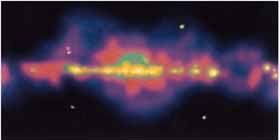|
The spotlight may seem to shine more brightly on scientists who interpret data than on those who crunch the numbers that make it possible. But U of C statistician Eric D. Kolaczyk, SB'90, knows the value of his role in developing the computer program that helped discover a halo of gamma rays around the Milky Way.
"In some sense, my two collaborators are the concert pianists who turned out this wonderful piece, and I made the piano," says the 29-year-old Kolaczyk, an assistant professor in statistics. "They could not have made the music without the piano."
Using Kolaczykís program, Dave Dixon, a physicist at the University of California, Riverside, and Dieter Hartmann, an astrophysicist at Clemson, found an aurora of gamma rays thousands of light years thick that may surround the entire Milky Way. The scientists presented their discovery at last Novemberís meeting of the high- energy astrophysics division of the American Astronomical Society.
"There isnít any obvious source for these gamma rays," says Dixon, though he and Hartmann have suggested several possible explanations. Perhaps the halo occurs when high-energy cosmic rays collide with photons of low-energy light, such as visible or infrared light. Or perhaps it is emitted by rapidly spinning neutron stars. It could even be evidence of dark matter, the missing mass of the universe that scientists have not been able to observe directly.
The physicists collected their data on the halo using a telescope aboard the Compton Gamma Ray Observatory orbiting Earth. The telescope recorded the direction and energy of gamma-ray photons, but the pictures it produced were blurred by "noise" similar to the static on a TV screen. The physicists needed a program that could create more meaningful pictures, so last February, through an on-line newsletter, Dixon contacted Kolaczyk, who had been working on some relevant imaging tools. The statistician, who earned his Ph.D. from Stanford, began working with the physicists via telephone and the Internet, never to meet them in person.
Relying on statistical techniques and a new imaging tool called the wavelet transform, Kolaczyk spent the spring perfecting an applicable algorithm. The resulting computer program-Translationally Invariant Poisson Smoothing using Haar wavelets, or TIPSH-is able to "denoise" signals and images by assigning high numeric values to useful data and low values to noise. Allowing only data that crossed a certain threshold value to appear in the final picture, the program created a clear image of the hidden halo.
Kolaczyk, who is spending the year as a visiting assistant professor at Harvard, is now experimenting with other methods that would achieve the same results without relying on wavelets. Advances in the technique, he hopes, may one day lead to more information about the universeís mysterious dark matter.-C.S. |
|



